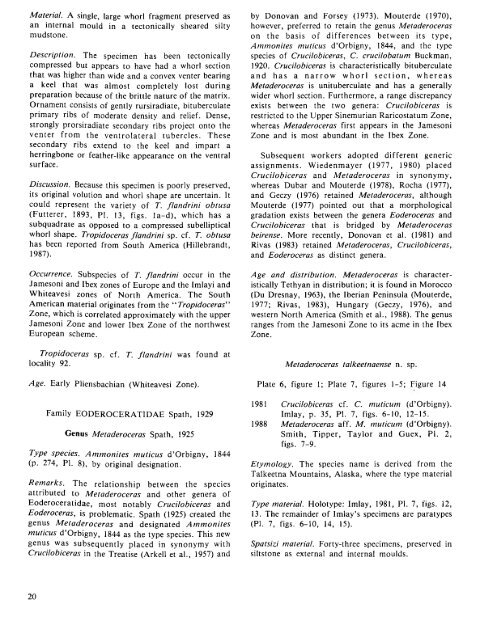PLIENSBACHIAN (LOWER JURASSIC) BIOSTRATIGRAPHY AND ...
PLIENSBACHIAN (LOWER JURASSIC) BIOSTRATIGRAPHY AND ...
PLIENSBACHIAN (LOWER JURASSIC) BIOSTRATIGRAPHY AND ...
Create successful ePaper yourself
Turn your PDF publications into a flip-book with our unique Google optimized e-Paper software.
Material. A single, large whorl fragment preserved as<br />
an internal mould in a tectonically sheared silty<br />
mudstone.<br />
D escription. The specimen has been tectonically<br />
compressed but appears to have had a whorl section<br />
that was higher than wide and a convex venter bearing<br />
a keel that was almost completely lost during<br />
preparation because of the brittle nature of the matrix.<br />
Ornament consists of gently rursiradiate, bituberculate<br />
primary ribs of moderate density and relief. Dense,<br />
strongly prorsiradiate secondary ribs project onto the<br />
venter from the ventrolateral tubercles. These<br />
secondary ribs extend to the keel and impart a<br />
herringbone or feather-like appearance on the ventral<br />
surface.<br />
Discussion. Because this specimen is poorly preserved,<br />
its original volution and whorl shape are uncertain. It<br />
could represent the variety of T. fla n d rin i obtusa<br />
(Futterer, 1893, PI. 13, figs. la-d), which has a<br />
subquadrate as opposed to a compressed subelliptical<br />
whorl shape. Tropidoceras flandrini sp. cf. T. obtusa<br />
has been reported from South America (Hillebrandt,<br />
1987).<br />
Occurrence. Subspecies of T. flandrini occur in the<br />
Jamesoni and Ibex zones of Europe and the Imlayi and<br />
Whiteavesi zones of North America. The South<br />
American material originates from the “ Tropidoceras”<br />
Zone, which is correlated approximately with the upper<br />
Jamesoni Zone and lower Ibex Zone of the northwest<br />
European scheme.<br />
Tropidoceras sp. cf. T. fla n d rin i was found at<br />
locality 92.<br />
A ge. Early Pliensbachian (Whiteavesi Zone).<br />
Family EODEROCERATIDAE Spath, 1929<br />
Genus M etaderoceras Spath, 1925<br />
Type species. A m m o n ite s m uticus d ’Orbigny, 1844<br />
(p. 274, PI. 8), by original designation.<br />
R em a rks. The relationship between the species<br />
attributed to M etaderoceras and other genera of<br />
Eoderoceratidae, most notably Crucilobiceras and<br />
Eoderoceras, is problematic. Spath (1925) created the<br />
genus M eta d ero cera s and designated A m m o n ite s<br />
m uticus d ’Orbigny, 1844 as the type species. This new<br />
genus was subsequently placed in synonymy with<br />
Crucilobiceras in the Treatise (Arkell et al., 1957) and<br />
by Donovan and Forsey (1973). Mouterde (1970),<br />
however, preferred to retain the genus M etaderoceras<br />
on the basis of differences between its type,<br />
A m m onites m uticus d’Orbigny, 1844, and the type<br />
species of Crucilobiceras, C. crucilobatum Buckman,<br />
1920. Crucilobiceras is characteristically bituberculate<br />
and has a n a rro w w h o rl s e c tio n , w h ereas<br />
M etaderoceras is unituberculate and has a generally<br />
wider whorl section. Furthermore, a range discrepancy<br />
exists between the two genera: Crucilobiceras is<br />
restricted to the Upper Sinemurian Raricostatum Zone,<br />
whereas Metaderoceras first appears in the Jamesoni<br />
Zone and is most abundant in the Ibex Zone.<br />
Subsequent workers adopted different generic<br />
assignments. W iedenmayer (1977, 1980) placed<br />
C rucilobiceras and M etaderoceras in synonymy,<br />
whereas Dubar and Mouterde (1978), Rocha (1977),<br />
and Geczy (1976) retained Metaderoceras, although<br />
Mouterde (1977) pointed out that a morphological<br />
gradation exists between the genera Eoderoceras and<br />
Crucilobiceras that is bridged by M etaderoceras<br />
beirense. More recently, Donovan et al. (1981) and<br />
Rivas (1983) retained M etaderoceras, Crucilobiceras,<br />
and Eoderoceras as distinct genera.<br />
A g e and distribution. M etaderoceras is characteristically<br />
Tethyan in distribution; it is found in Morocco<br />
(Du Dresnay, 1963), the Iberian Peninsula (Mouterde,<br />
1977; Rivas, 1983), Hungary (Geczy, 1976), and<br />
western North America (Smith et al., 1988). The genus<br />
ranges from the Jamesoni Zone to its acme in the Ibex<br />
Zone.<br />
M etaderoceras talkeetnaense n. sp.<br />
Plate 6, figure 1; Plate 7, figures 1-5; Figure 14<br />
1981 Crucilobiceras cf. C. m uticum (d’Orbigny).<br />
Imlay, p. 35, PI. 7, figs. 6-10, 12-15.<br />
1988 M etaderoceras aff. M . m uticum (d’Orbigny).<br />
Smith, Tipper, Taylor and Guex, PI. 2,<br />
figs. 7-9.<br />
E tym ology. The species name is derived from the<br />
Talkeetna Mountains, Alaska, where the type material<br />
originates.<br />
Type material. Holotype: Imlay, 1981, PI. 7, figs. 12,<br />
13. The remainder of Imlay’s specimens are paratypes<br />
(PI. 7, figs. 6-10, 14, 15).<br />
Spatsizi material. Forty-three specimens, preserved in<br />
siltstone as external and internal moulds.

















